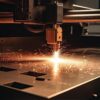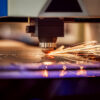In the world of precision manufacturing, laser turning is rapidly gaining traction as a powerful alternative to traditional turning methods. The use of a focused laser beam offers significant advantages in terms of precision, speed, material versatility, and overall efficiency. Let’s explore why laser turning is becoming the preferred choice for many industries.
Understanding the Basics
- Traditional Turning: This well-established method involves rotating a workpiece against a fixed cutting tool to remove material and shape the part.
- Laser Turning: Instead of a physical cutting tool, laser turning utilizes a high-intensity laser beam to melt and vaporize material with extreme precision. The workpiece rotates, and the laser is precisely guided for cutting.
Key Advantages of Laser Turning
-
Unmatched Precision: Laser beams can be focused to extremely fine points, allowing for intricate cuts and complex geometries impossible with traditional turning. Tolerances are significantly tighter, especially with thin-walled or delicate parts.
-
Speed and Agility: The non-contact nature of laser turning eliminates tool wear and reduces setup times. This translates to faster production cycles, making it ideal for rapid prototyping and high-volume runs.
-
Material Versatility: Lasers can cut a wide range of materials, including hard metals, brittle ceramics, and even some composites. This opens up possibilities for parts that are challenging or impossible to machine conventionally.
-
Minimal Heat-Affected Zone (HAZ): The focused energy of the laser beam minimizes heat transfer to the rest of the workpiece. This reduces distortion, warping, and the need for post-processing due to thermal stress.
-
Reduced Waste: Laser turning produces very little material waste compared to traditional machining, which can generate significant chips and shavings.
When is Laser Turning the Best Choice?
- Complex Shapes: Laser turning excels at producing parts with intricate features, small radii, and internal details.
- Hard or Brittle Materials: If conventional cutting tools struggle with the material, laser turning is often a superior solution.
- Tight Tolerances: When extreme precision is paramount, laser turning consistently delivers.
- Rapid Prototyping: Laser turning’s speed and flexibility make it a go-to choice for product development and iteration.
The Future of Manufacturing
As laser technology continues to advance, laser turning is poised to become even more prevalent in various industries. Its ability to produce high-quality parts with speed and flexibility makes it an essential tool in the modern manufacturing landscape.
If you’re looking to optimize your production processes, it’s worth exploring whether laser turning could be the right solution for your manufacturing needs.







